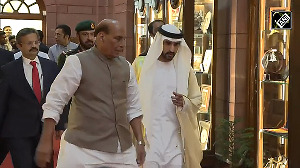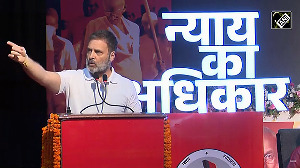It's a project to turn science fiction into futuristic reality. At Velbionanotech, a little-known Bangalore-based company, researchers are working on pathbreaking projects that -- if successful -- might dramatically reduce the need for heart surgery or for kidney stone operations.
What's the frontier technology Velbionanotech is developing? It's working on designing nanochips, which will deliver a drug exactly to the affected area in the body.
So, one project aims to develop a chip which when injected into the body will head towards the kidney and remove stones. Another -- even more ambitious project -- aims to develop a nanochip that will move into the heart and reduce the fatty tissues that cause arteriosclerosis.
Says Joseph Asantraj, chairman and CEO, Velbionanotech, who has been focusing on these areas for the last two years: "We have completed the designing stage of the nanochips and have started developing a prototype of the product. Commercialisation will take another two to three years. And these products will be cheaper than undergoing surgery."
Asantraj's dream is still a long way from reality. But nanotechnology is already transforming the world in which we live. The textile industry is selling stain- and wrinkle-resistant fabrics based on nanotechnology.
And companies like LG and Samsung are selling nanotech-based refrigerators that keep food fresh for longer periods and air-conditioners that ensure fresh air. Says Ravinder Zutshi, vice president Samsung India, "Nano-technology offers us an opportunity to reinforce our health platform USP."
Experts predict that by 2010 the global market for nanotechnology-based products could be a staggering $1 trillion. Nanotechnology will be used to make everything from metals that are stronger than steel to new computer disks that will store infinitely more than anything on the market currently.
And don't imagine that nanotechnology is only being used by NASA or the geeks of Silicon Valley. Indian companies and MNCs are already wooing Indian consumers with nano-products. And a clutch of science labs and R&D centres are racing to develop nano-products.
Look at what's already happening. Out in front are textile majors like Arvind, Group Ashima, Raymonds and Grasim, which are hawking stain-resistant, wrinkle-free and even odour-free garments and fabrics. What's more these new manmade fabrics, made using nano-chemicals, feel like cotton.
Says Darshan Mehta, president, Arvind Brands (which controls brands like Arrow and Lee): "Nano has for the first time brought a sea change in fabric technology in an areas where the scope for real innovation was limited."
Nanotechnology has already transformed the textile industry. At Arvind, for instance, one out every of five shirts in the Arrow office range currently uses some nano-based chemical to make it stain-resistant and wrinkle-free.
The company also says that 20 per cent of its trousers are made from nano-treated fabric. It is now testing nano-chemicals on its denims.
Arvind isn't the only textile company that's making it big with nano-technology. Raymonds has had a big hit with its nano-treated trousers and is now launching nano-shirts under the Park Avenue label.
Says an optimistic Shreyas Joshi, executive director, Raymond Apparels: "Nano-based trousers constitute 10 per cent of our total trouser sales. It should go up to 25 per cent very soon."
It's the same story at other textile companies. Mohan Clothing, makers of Blackberry's has already introduced nano-based trousers.
Says Nitin Mohan, one of the promoters "We will use nano for our premium products and hope that they will be the top sellers in this range."
The textile mills have also hit the jackpot -- they are selling large quantities of nano-treated fabrics, especially in the international market.
Group Ashima for instance has exported over 1 million yards of fabric this season (in a three-month period) to top retailers like Gap and Banana Republic. Says Atul Singh, group president, operations: "As much as 15 per cent of our fabric exports this season were of nano-treated fabrics."
But it isn't only textiles that is feeling the wind of nano-tech change. Hop across to another side of the country. Picture tube manufacturer Samtel has gone into partnership with the IIT Kanpur to research the possibility of making organic light emitting diodes -- which are much brighter and save more energy compared to liquid crystal displays used on flat TV sets and mobile phones. OLEDs have an additional advantage because they do not require backlighting like an LCD.
Philips is going even further. In the next two months it plans to launch wearable MP3s -- the newest craze abroad. The keyring-size player can offer you six to 12 hours of music and has an easy-to-use remote control built into the soft fabric neck strap.
There are even more exotic products being lined up. Titan Industries is developing a range of "body wearable" healthcare devices.
For starters, there'll be a "pedometer" which can be worn on a person's belt or used as a tie clip that will monitor calories burnt while walking or jogging.
Another product also under development monitors blood pressure. Says Bhaskar Bhatt, managing director, Titan Industries: "The product will take another two or three months and is part of trying to extend our product line to the personal products category."
The new products hitting the shelves are being backed by giant R&D initiatives taking place around the globe. And India fits in here because of its low-cost techno-scientific power base.
Of course the Government is chipping in. The Department of Science and Technology has launched a national nanotech programme and backed it with $10 million. A second $15 million programme for research on smart materials is also being used to fund various projects. And defence labs are pouring cash into nano research.
Also, companies are looking at building up collaborations with science labs. One example is the tie up between the Indian Institute of Science in Bangalore and the Mumbai-based Cranes Software International.
The two have set up a centre on micro electro mechanical systems where nano technology is used for miniaturisation of electronic and mechanical devices.
The research is already yielding dividends. The lab has applied for a patent for an MEMS microphone, which can be used in hearing aids.
Says Dr Rudra Pratap who heads the lab: "The MEMS lab is careful to be very focused and is working on just a few things. This list includes acoustic sensors (microphone), ultrasound transducers and inertial sensors."
- US-based Nano-tex -- a fast-growing nanotechnology company -- is planning an R&D centre in India
- Samsung and LG have introduced ACs and refrigerators using nano-coating to kill bacteria
- Philips is introducing wearable MP3 players which have easy-to-use remote controls built into the soft fabric neck strap
- Samtel is working on OLED which saves energy and is much brighter than LCDs
- Group Ashima has exported over 1 million yards of nano-treated fabric this season (in a three-month period) to top retailers like Gap and Banana Republic
At another level, US companies are looking at outsourcing research. US-based Nano-tex -- a fast-growing nanotech company -- which is selling to Indian companies -- is already planning an R&D centre in India.
Apart from using Indian scientists it also wants to leverage the time difference between its lab in the US. Says Nitin Jain, country head, Nano-tex India: "Technically we can cut down our development work by half by utilising the time difference."
Venture capital funds are also joining the bandwagon. Velbionanotech, for instance, is talking to ICICI Venture. Says Alluri Srinivasa, senior vice-president, ICICI Venture: "We are looking at nanotechnology-based companies very closely. Initially our strategy would be to invest in lower-end applications like drug-delivery systems and then go up the learning curve."
ICICI is also approaching US-based nanotech companies, which might look at outsourcing part of their research to India, through joint ventures. It hopes to make its first investment in a nanotech company within two to three months.
Smaller incubators, which help companies when their projects are at an early stage are also leaping into the nano-picture. Pune based India Nano, for instance, has identified over 20 nanotechnology-based projects that it will back.
Rahul Patwardhan, who runs Indian Nano (and a clutch of other venture capital funds), says his company may invest between Rs 20 lakh (Rs 2 million) and $2 million in these projects. His company is looking at a seven to 10-year timeframe for returns. Patwardhan isn't divulging precise details about what his company is backing but he does give some broad outlines.
One, for instance, is looking at nano-calcium carbonate. This product could possibly help paint companies by creating products, which spread better and are, therefore, more economical to use.
Also, it might be used to make paper with higher whiteness levels. The start-up will probably need about Rs 5 crore (Rs 50 million) to Rs 7 crore (Rs 70 million).
One company that is confident about India is Nano-tex. Success in the textile sector (12 million yards of fabric in 12 months) has persuaded it to bring in its latest products from the US. One such product is an odour management chemical, which converts sweat on the fabric into fragrance or removes the odour.
Putting money into nanotechnology is, of course, a risky game and the venture capitalists could get burnt. Agrees Patwardhan: "It's a high-risk area. Out of the 20 projects we have taken we will be happy even if two or three succeed."
Adds a senior executive of the country's leading venture capital fund: "The Internet fiasco has taught us not to put money in start-ups. Nano tech companies are mostly in the stage of research and product development and are very high risk."
Also, most nano-tech products are expensive. And that might prevent them being used in mass-scale products. A senior LG India executive says the company will charge a premium of between 7 per cent to 8 per cent on nano coated products. That is why it will only be installed on the more expensive refrigerators.
Similarly, the textile companies reckon that nano-chemical will constitute over 33 per cent of the fabric's selling price.
As a result Arrow charges a premium of around Rs 200 on a nano-treated shirt compared to a normal product. Agrees Mehta: "It is still not affordable for mass scale manmade garments."
There are grouses that the Government isn't putting enough money into the field. The American government has allocated over $700 million annually on nanotech research. Not to left behind, the EU has approved a budget of 16 billion euros for research.
Laments a senior executive involved in the nanotech industry: "We are fighting huge odds. The Government is still not ready to take the risk to fund in this sunrise area. Without that we will miss the bus."
That may or may not be true. There is lots of over-hype around nanotechnology. But with a large consumer base hungry for new products India could be a key market for nano-based products in the years to come.
|
Nanotechnology explained What is nanotechnology? Well, let's start by saying that in nanotechnology size matters. A nanometer is a microscopic measure that is a billionth of a metre. Put it another way -- it's 1/750,000th of a strand of hair. Nanotechnology is the science of working with atoms or molecules of this size. It is science fiction come true. That, amongst other things, allows scientists to create new materials that are stronger, smaller and tougher than anything known till now. Scientists reckon that nanotechnology will eventually affect every industry and consumer in the world. They may be used to create metals and build bridges or to develop the next generation of computing. There are already innovative fabrics and researchers are working on new drug delivery systems which could dramatically reduce the need for surgery. The history of nantechnology began in 1959 when Nobel prize winner Richard Feynman suggested that there were no scientific laws, which prevented man from manipulating matter atom by atom. Simply put, Feynman suggested that matter could be build bottom-up -- atom by atom. IBM made research possible by inventing a specialised microscope, which could image samples of atoms at the nanoscale level. Fast forward to the late '80s, when researchers in Rice University made the first big bang invention: they exhibited a molecule of carbon which could conduct electricity and heat and while it was stronger than steel it was lighter than plastic. After that there was no looking back. |
Additional reporting: Subir Roy and Arti Sharma






 © 2025
© 2025